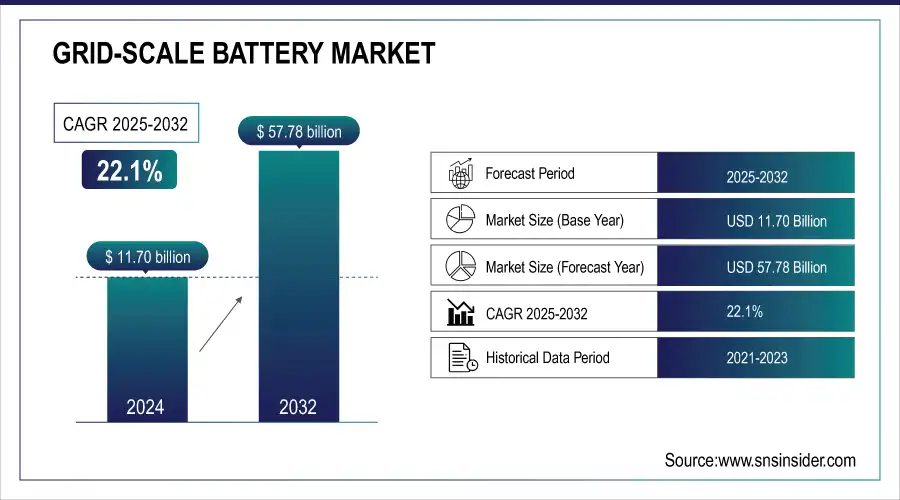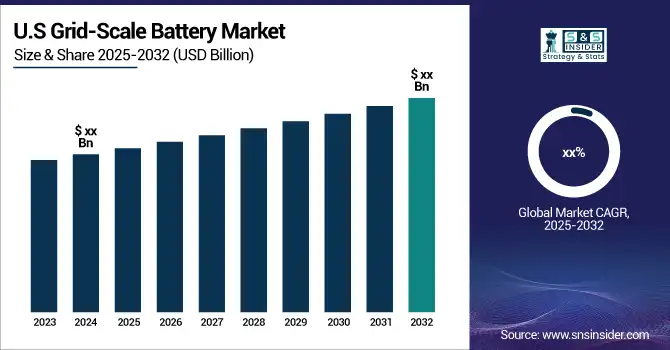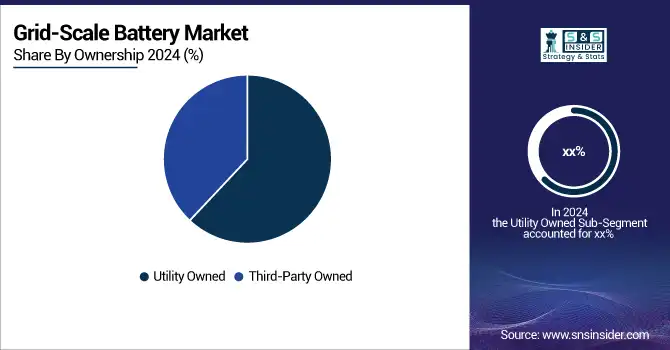Grid-Scale Battery Market Report Scope and Overview:
The Grid-Scale Battery Market size was valued at USD 11.70 billion in 2024 and is projected to reach USD 57.78 billion by 2032 With a Growing CAGR of 22.1% over the forecast period of 2025-2032.
A grid-scale battery, also known as a utility-scale battery, is a large-scale energy storage system designed to support and stabilize electrical grids. It plays a crucial role in the integration of renewable energy sources, into the existing power infrastructure. The primary function of a grid-scale battery is to store excess electricity generated during periods of low demand and release it during peak demand periods. This helps to balance the supply and demand of electricity, ensuring a reliable and stable power supply for consumers.

Get more information on Grid-Scale Battery Market - Request Sample Report
Grid-scale batteries are typically composed of multiple battery modules, which are interconnected to form a single energy storage system. These modules are often based on lithium-ion technology, known for its high energy density and long cycle life. However, other technologies like flow batteries and sodium-ion batteries are also being explored for grid-scale applications. One of the key advantages of grid-scale batteries is their ability to provide fast response times. They can rapidly inject power into the grid or absorb excess power, helping to maintain grid stability and prevent blackouts. Additionally, grid-scale batteries can also provide ancillary services, such as frequency regulation and voltage support, further enhancing the reliability and efficiency of the electrical grid.

Grid-Scale Battery Market Highlights:
-
Market growth drivers include increasing adoption of renewable energy sources and the transition toward sustainable power solutions supported by declining battery costs and improved energy storage performance
-
Renewable energy integration is driven by heavy investments in solar, wind, and hydropower projects supported by policies, tax incentives, and falling technology costs to reduce reliance on fossil fuels and lower emissions
-
Cost decline of battery technologies due to advancements in battery chemistry and manufacturing processes has led to lower costs, improved efficiency, and longer lifespans making grid-scale batteries more viable
-
High initial investment remains a major barrier as significant upfront costs for battery systems, energy management, and grid integration infrastructure often limit adoption to large utilities or government-supported projects
-
Integration of grid-scale batteries with smart grid infrastructure enhances energy management, frequency regulation, and peak load balancing while supporting demand response and improving grid resilience
-
Future outlook indicates that combining intelligent grid systems with large-scale storage will accelerate the transition to sustainable energy ensuring reliable power supply and better utilization of renewable sources
The market for grid-scale batteries has witnessed significant advancements in recent years, driven by the increasing adoption of renewable energy sources and the growing demand for sustainable power solutions. As the world transitions towards a cleaner and greener future, the need for efficient energy storage becomes paramount. One of the key drivers of this market is the declining costs of battery technologies. The prices of lithium-ion batteries, which are widely used in grid-scale applications, have been steadily decreasing, making them more economically viable. Additionally, advancements in battery chemistry and manufacturing processes have led to improved performance and longer lifespans, further bolstering the market's growth.
Grid-Scale Battery Market Drivers:
-
Growing demand for renewable energy sources
The growing demand for renewable energy sources is driven by the global shift towards sustainable power generation, aiming to reduce dependence on fossil fuels and lower greenhouse gas emissions. Governments and industries worldwide are increasingly investing in solar, wind, and hydropower projects to achieve carbon neutrality and meet rising energy needs. Technological advancements in energy storage, grid infrastructure, and battery systems further support the integration of intermittent renewables into power grids. Additionally, supportive policies, tax incentives, and declining costs of renewable technologies are encouraging large-scale adoption, fostering energy security, economic growth, and environmental sustainability across diverse regions and industries.
Grid-Scale Battery Market Restraints:
- High initial investment required for grid-scale battery installations
High initial investment required for grid-scale battery installations is one of the primary barriers to widespread adoption. These systems involve significant upfront costs for advanced battery technologies, energy management systems, and grid integration infrastructure. Expenses include procurement of high-capacity batteries, installation, land acquisition, safety compliance, and supporting components like inverters and cooling systems. Additionally, the need for skilled labor and engineering expertise increases project costs. Although operational and maintenance expenses are relatively low over the long term, the high capital expenditure often limits adoption to large utilities, government-supported projects, or partnerships with financial incentives, delaying broader market penetration.
Grid-Scale Battery Market Opportunities:
- Integration of grid-scale batteries with smart grid infrastructure
Integration of grid-scale batteries with smart grid infrastructure enhances the reliability, flexibility, and efficiency of modern power systems. These batteries enable real-time energy storage and release, helping balance supply and demand while accommodating intermittent renewable energy sources like solar and wind. Smart grids use advanced communication, automation, and analytics to optimize battery performance, manage peak loads, and reduce transmission losses. This integration also supports demand response programs, frequency regulation, and backup power during outages. By combining intelligent grid management with large-scale energy storage, utilities can achieve improved grid resilience, better energy utilization, and a smoother transition toward sustainable energy systems.
Grid-Scale Battery Market Segment Analysis:
By Ownership
Utility-owned grid-scale battery systems dominate the market, as utilities increasingly invest in large-scale energy storage to enhance grid stability, support renewable integration, and meet regulatory requirements. These projects benefit from strong capital backing and established infrastructure. Meanwhile, third-party ownership is growing steadily, driven by independent power producers and energy-as-a-service models that offer flexible financing, faster deployment, and reduced upfront costs for end users.

By Type
Lithium-ion batteries dominate the grid-scale storage market, being the most widely deployed in front-of-the-meter applications due to their high energy density, reliability, and established supply chains, particularly across utility projects in North America. At the same time, lithium-ion technology continues to expand rapidly with advancements and cost reductions, while sodium-based batteries, including sodium-ion and sodium-sulfur, are emerging as strong alternatives in regions with abundant sodium resources. Additionally, flow batteries, especially vanadium redox flow, are gaining momentum for their long cycle life, durability, and suitability for long-duration energy storage applications.
By Application
Renewable energy integration dominates the grid-scale battery market, driven by the growing deployment of solar and wind projects that require efficient storage solutions to stabilize power supply. Ancillary services, including frequency regulation and grid balancing, are rapidly expanding as utilities seek enhanced reliability. Backup power and peak shifting are also gaining traction, supporting load management and uninterrupted energy availability across diverse sectors.
Grid-Scale Battery Market Regional Analysis:
North America Grid-Scale Battery Market Trends:
North America leads the grid-scale battery market and is projected to retain its dominance throughout the forecast period. The region benefits from a mature electricity grid, significant renewable energy integration, and strong policy support driving large-scale storage adoption. The United States spearheads deployments with advanced lithium-ion and emerging sodium-based batteries, while Canada is expanding its capacity for renewable integration. Technological advancements, declining costs, and grid modernization initiatives further enhance energy reliability, peak demand management, and overall grid stability across the region

Get Customized Report as per your Business Requirement - Request For Customized Report
Europe Grid-Scale Battery Market Trends:
Europe is emerging as a leading region in the grid-scale battery market, driven by ambitious renewable energy targets and strong regulatory support from the European Union. The region has heavily invested in wind and solar power, creating substantial demand for large-scale energy storage solutions. Favorable policies, carbon reduction initiatives, and financial incentives have accelerated deployments, while advancements in lithium-ion, sodium-ion, and flow battery technologies enhance grid reliability and flexibility. Countries like Germany, the UK, and France are at the forefront of integrating batteries to balance intermittent renewable generation and meet their climate neutrality goals.
Asia-Pacific Grid-Scale Battery Market Trends:
Asia-Pacific is witnessing rapid growth in the grid-scale battery market, fueled by rising electricity demand, large-scale renewable energy projects, and supportive government policies. China leads the region with massive investments in lithium-ion and emerging sodium-based battery technologies, while Japan and South Korea focus on advanced storage solutions to support their smart grid initiatives. India is also gaining traction, with growing adoption driven by renewable integration and national energy storage policies. The region benefits from abundant manufacturing capabilities and technological innovation, positioning it as a key hub for both production and deployment of grid-scale storage systems.
Latin America Grid-Scale Battery Market Trends:
Latin America is experiencing steady growth in grid-scale battery installations, supported by expanding renewable energy projects, particularly in solar- and wind-rich countries such as Brazil, Chile, and Mexico. Governments are increasingly implementing supportive frameworks to attract foreign investment in clean energy infrastructure. While the market is still in its early stages compared to developed regions, the integration of energy storage solutions is expected to accelerate to improve grid stability, manage peak loads, and reduce reliance on fossil-fuel-based backup systems.
Middle East & Africa Grid-Scale Battery Market Trends:
The Middle East & Africa (MEA) region is gradually adopting grid-scale battery systems to support the diversification of its energy mix and integrate renewable resources, especially solar power. Countries like Saudi Arabia and the United Arab Emirates are investing in large-scale energy storage as part of their clean energy transition strategies. In Africa, grid-scale batteries are increasingly being deployed to stabilize power supply in regions with weak or unreliable grid infrastructure. While adoption is still limited, supportive government initiatives and declining storage costs are expected to drive significant growth in the coming years.
Grid-Scale Battery Market Highlights:
-
Tesla, Inc.
-
Contemporary Amperex Technology Co., Ltd. (CATL)
-
BYD Company Limited
-
LG Energy Solution
-
Samsung SDI Co., Ltd.
-
Panasonic Corporation
-
Fluence Energy, Inc.
-
NGK Insulators, Ltd.
-
General Electric (GE)
-
ABB Ltd.
-
Saft Groupe S.A.
-
GS Yuasa Corporation
-
Exide Technologies
-
S&C Electric Company
-
Toshiba Corporation
-
VRB Energy
-
Ambri Incorporated
-
Redflow Limited
-
24M Technologies, Inc.
-
KORE Power, Inc.
Grid-Scale Battery Market Competitive Landscape:
24M Technologies, Inc., established in 2010 and headquartered in Cambridge, Massachusetts, is a pioneer in semi-solid lithium-ion battery technology. Its innovative SemiSolid™ process reduces production costs, enhances energy density, and improves safety. The company focuses on grid-scale energy storage and electric mobility through strategic partnerships and global licensing initiatives.
-
On April 14, 2023, 24M announced that they have received a contract of USD 3.8 million from the United States Advanced Battery Consortium LLC (USABC). This exciting two-year project, with a 50 percent cost share, will be dedicated to the development of an innovative and affordable EV battery technology that enables fast-charging capabilities.
| Report Attributes | Details |
| Market Size in 2024 | USD 11.70 Billion |
| Market Size by 2032 | USD 57.78 Billion |
| CAGR | CAGR of 22.1% From 2025 to 2032 |
| Base Year | 2024 |
| Forecast Period | 2025-2032 |
| Historical Data | 2021-2022 |
| Report Scope & Coverage | Market Size, Segments Analysis, Competitive Landscape, Regional Analysis, DROC & SWOT Analysis, Forecast Outlook |
| Key Segments | • By Type (Lead-acid, Sodium-based, Lithium-ion, Redox Flow, and Others) • By Ownership (Third-Party Owned and Utility Owned) • By Application (Renewables Integration, Ancillary Services, Backup Power, Peak Shifting, and Others) |
| Regional Analysis/Coverage | North America (US, Canada), Europe (Germany, UK, France, Italy, Spain, Russia, Poland, Rest of Europe), Asia Pacific (China, India, Japan, South Korea, Australia, ASEAN Countries, Rest of Asia Pacific), Middle East & Africa (UAE, Saudi Arabia, Qatar, South Africa, Rest of Middle East & Africa), Latin America (Brazil, Argentina, Mexico, Colombia, Rest of Latin America). |
| Company Profiles | Tesla, Inc., Contemporary Amperex Technology Co., Ltd. (CATL), BYD Company Limited, LG Energy Solution, Samsung SDI Co., Ltd., Panasonic Corporation, Fluence Energy, Inc., NGK Insulators, Ltd., General Electric (GE), ABB Ltd., Saft Groupe S.A., GS Yuasa Corporation, Exide Technologies, S&C Electric Company, Toshiba Corporation, VRB Energy, Ambri Incorporated, Redflow Limited, 24M Technologies, Inc., KORE Power, Inc. |

